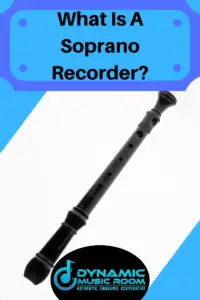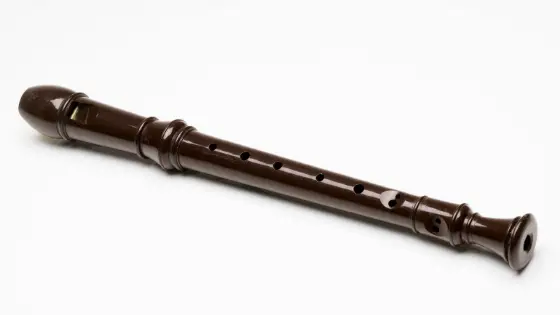I’ve taught this instrument for years now, but one day earlier this fall, one of my students stopped me to ask: What is a soprano recorder?
I gave the best answer I could, but I wanted to do better for my students. So I did some research, and this is what I found.
A soprano recorder is a woodwind instrument and member of the flute family specifically. This instrument is pitched in the key of C and was a staple of the Renaissance and Baroque periods, but this instrument has since gained massive popularity as an instrument to use in elementary school music classrooms.
Read on for details about the instrument including a description, key, explanation of why it’s in schools, and other common questions.
Table of Contents
Brief Description Of The Soprano Recorder
Whole articles have been written on the soprano recorder (check out the best books) and its history. This section is just meant as a crash course in the important aspects of recorder.
Physical Description
The soprano recorder is an 11.81 inches woodwind instrument. The instrument is often made of three different pieces:
- Head
- Body
- Foot
Traditionally, the instrument was made out of wood, but modern recorders are most often seen made out of plastic. But still today, recorders made out of wood are considered to be better.
The recorder is meant to be played straight up and down not horizontally like its cousin the transverse flute.
There is one hole in the top for the player to breathe into. The next one is rectangular shaped called the labium (or window) where the sound is produced.
On the back, there is one thumb hole which helps control the higher and lower partials. On the front, there are 7 holes (2 of which are doubled) which control the specific pitch.
There is also a hole in the bottom of the recorder. This isn’t of much use in today’s classroom, but performers from before were known to cover it with their knees to alter the timbre of the recorder.
How The Soprano Recorder Makes Sound
The soprano recorder makes sound similar to its cousin and descendant, the flute. When the player blows into the mouthpiece, there is a piece called the block which serves to force the air down the narrow wind way.
The air travels through the wind way until it comes into contact with the sharp piece called the labium. The air alternates at fast speeds between exiting the recorder out of the labium (or window, some call it).
This alternating cause the standing waves to vibrate and create sound. The feedback from the resonance of the recorder body creates the pitch.
Covering different holes changes the resonance in the recorder and therefore changes the pitch.
Check out this clip for a good visual of the process. On a side note, kids love watching these goofy videos.
Brief History
The earliest mentions of recorders come from as early as the 1300s. They were used as a general instrument and often substituted for vocal parts.
As music progressed into the Renaissance period, the recorder consort (small ensemble of recorders) became more established, and the instruments were tuned to fifths as they are with today’s recorders as well.
Recorders began to serve an essential purpose as a melody and ornamental instrument in the expanding Baroque ensembles.
Around this time, the flute came onto the scene. With the ensembles getting louder and more complicated, the recorder was falling behind, and the flute became more popular.
For a more detailed history of the recorder, check out the history of the recorder.
How Long Is A Soprano Recorder?
The soprano recorder is the common type of recorder for teaching music and is around 11.81 inches or 30 centimeters long. It also will often have the lead or melody in recorder consorts.
What Key Is The Soprano Recorder In?
The soprano recorder plays an octave higher than the human voice in the key of C and is played an octave higher than written in the treble clef. Its lowest pitch with all holes covered is C5, and the highest standard pitch is C7.
However, due to fingering combinations and partial holes, the soprano recorder can play any key and any pitch. (How loud is a soprano recorder?)
Typically, reading the recorder is simple and you play matching the treble clef. You don’t have to worry about transposition or any octave reading.

Why Do We Use Soprano Recorder In Schools?
As I constantly joke with parents, the recorder wasn’t designed as a device by which music teachers torture parents. It’s a real instrument.
There are many reasons to teach recorders. Here are a few of my favorite ones.
Persistence – Learning a new instrument like the recorder is NOT easy. But students need to learn that with persistent effort, they can improve and achieve great things.
Practice Skills – Getting better at something doesn’t just happen. We know it takes intentional practice.
I try hard to emphasize that with my students. They can improve on anything (even recorder) with good, effective practice.
I simplify it for them with these steps:
- Think about what you’re doing.
- Try it.
- Reflect on what went badly.
- Practice that specific part at least 3 times.
- Try it again.
- Repeat until the whole song/piece/skill is solid.
- Come back later and see if it stuck.
- **Bonus: Challenge yourself.
These steps work for anything, music or not. But learning the recorder can really drive this home.
Coordination – Many people (students and adults alike) assume the recorder is as easy to play as a boom whacker. But the truth is: it requires much finer motor control than you would expect.
In developing children even as old as 8, 9, and 10, you can never get them to practice these fine motor skills enough. Doing so increases the brain’s elasticity in other areas as well.
Read more about the brain and fine motor control at NeuroScience News.
Music Literacy – Of course, music literacy and independent reading and performance are one of the goals in my music classroom. The recorder is a perfect way to start applying the reading skills your students have been developing.
Air Control – Breath control will serve many people well in musical endeavors such as singing and playing wind instruments. But it can also work to help athletes.
The recorder requires breath control unlike any other activity your students have tried. It provides the perfect opportunity to talk about the mechanics of breathing and how to control it.
Listening For Timbre – On a personal level, I believe all good musicians have the perfect balance of technical skill and something I call “sound concept.”
Sound concept is the musician’s idea of what their voice or instrument should sound like. Then, their technical ability helps them produce this sound.
Without a good idea of what a trumpet should sound like, no trumpet player will ever sound good no matter how many scales they practice.
The recorder can help get young musicians on this path by becoming more sensitive to what other people sound like on the recorder.
I have my students listen to others besides just myself and help them realize what “good” sound or timbre is for this instrument. This will help them in the long run.
As I said before, there are many other reasons for teaching recorders. Check out a few of them in this great article, The Hidden Benefits Of Playing Recorders.
Are Soprano And Descant Recorders The Same?
Yes, soprano and descant recorders refer to the same recorder around 11.81 inches long and based on its lowest pitch, C5. The differences in the name descant and soprano are due to regional differences in the name of the instrument.
The name descant may also have been influenced by the part of the recorder would often play in early music periods. A descant part is typically considered an ornamental or counter-melody pitched higher than the melody of the piece.
What Are The 5 Types Of Recorders?
There are 5 main types of recorders in the modern recorder family. These recorders may be seen in Universities and in some elementary schools as well as period-specific ensembles.
In this section, we’ll look briefly at the 5* types of recorders, their function, and where you may see them.
Sopranino – The smallest of the modern recorders. This recorder starts on F5 and is seen in modern recorder consorts.
Soprano – The most common type of recorder. This recorder starts on C5 and is seen commonly in schools and plays the lead in recorder groups.
Alto – This type of recorder is also fairly common and based on the pitch F4. This recorder can be seen in older elementary schools where recorder playing is taken very seriously and recorder consorts all over.
Tenor – Less common, the tenor recorder starts on C4 (a full octave below the soprano). You only see this in recorder consorts or played by elementary music teachers looking for an instrument in the same range as their kids.
Bass – The bass recorder is rarely seen except in recorder consorts. This recorder starts on the pitch F3.
*There are other types of recorders out there besides these 5, but they are less common. Here are some other ones you may see and their starting pitches:
- Garklein/Piccolo – C6
- Great bass – C3
- Contrabass – F2
- Sub-great bass – C2
- Sub-contrabass – F1
Conclusion
I hope you enjoyed learning a little more about what the soprano recorder is. This instrument is a great tool for teaching basic music concepts with roots from hundreds of years ago.
Do you have any questions about teaching or using recorder? Hop on down to the comments and let us know.

